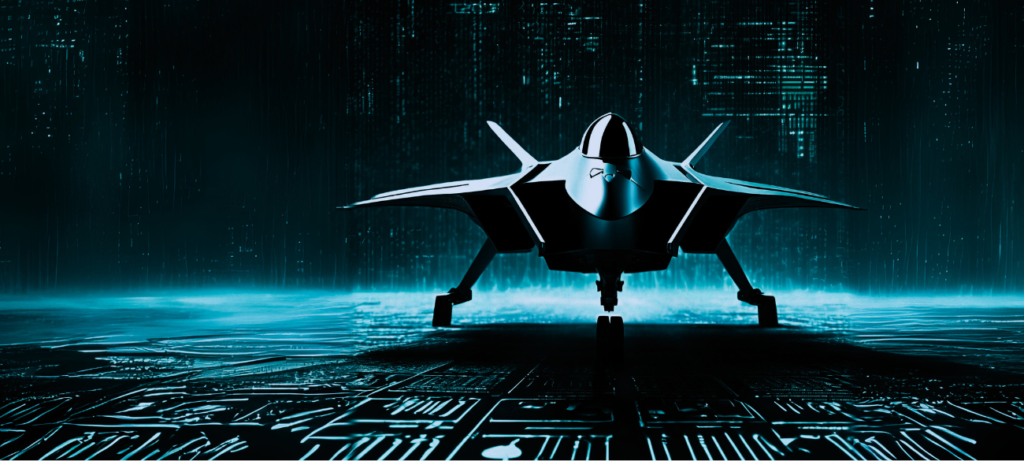In the future threat environment, air superiority will be challenged by rapid advancements in weapons systems and automation. Traditional approaches to the design of air power are becoming obsolete, and necessitate a shift toward low-footprint “kill webs” that promise enhanced agility. Non-kinetic capabilities, particularly electronic warfare and AI-enabled multi-domain integration, will prove decsivie for air forces to outmaneuver adversaries in future warfare.
Shift Paradigm.
The shift toward collaborative combat aircraft (CCA) will enhance capacity and resilience, but also operational complexity for air power. However, current CCA development prioritizes mission tasks over teaming dynamics. Effective CCA integration will demand human-CCA teams to be optimized by ensuring operator trust, maintaining human-in-the-loop control, and managing workload to create a reliable, attrition-tolerant force.

Heather R. Penney, Senior Resident Fellow, Mitchell Institute for Aerospace Studies, United States
The metaverse, though loosely defined, holds significant potential to enhance Joint All-Domain Operations (JADO) and may evolve into a new warfare domain itself. Metaverse characteristics bring alignment with JADO objectives and highlight new opportunities to leverage emerging technology for strategic advantage. However, risks accompany this potential, as virtual warfare can yield real-world consequences, and bring an impact greater than anticipated.

Dr. Tim Marler, Senior Engineer, RAND; and Professor, Pardee RAND Graduate School
Growing international interest in space is intensifying competition and the potential for conflict. To
strengthen deterrence and enhance security in space, training and education will be decisive. This paper examines how the U.S., a leading space power, tailors its programs to operate in an increasingly congested and contested domain, offering valuable insights for military actors adapting to the space-based requirements of future warfare.

Dr. Peter Hays, Professor of Space Policy and International Affairs, Space Policy Institute, George Washington University, United States
Military decision-makers should reexamine assumptions about the role of digital capabilities and AI in future combat systems. While acknowledging the importance of information technology, they must recognize the enduring significance of traditional military technologies. A balanced approach is essential, leveraging startup expertise cautiously, as forcing commercial practices into combat capabilities development may lead to failure.

Dr. Ted Harshberger, Senior Associate (Non-Resident), Defense-Industrial Initiatives Group, Center for Strategic and International Studies, United States
Dr. Cynthia R. Cook, Director, Defense-Industrial Initiatives Group, Center for Strategic and International Studies, United States
As operational landscapes evolve, militaries recognize the urgent need to harness the potential of artificial intelligence (AI) for adaptable capabilities. Introducing the concept of the “defense metaverse,” this approach constructs a dynamic digital twin of the battlespace, integrating AI and sophisticated models to refine tactical concepts. Highlighting successes like the GhostPlay project, it emphasizes prioritizing experimentation, training, and infrastructure to optimize AI-driven military capabilities.

Heiko Borchert, Co-Director, Defense AI Observatory, Germany
Torben Schütz, Research Fellow, Defense AI Observatory, Germany
AI is making its way into military operations and warfighters will increasingly co-exist with machines with progressively more advanced autonomous capabilities. As machines make the jump from simple tools to cooperative teammates, human-machine teaming will be at the center of warfare. Understanding how to ensure trust between humans and machines is critical.

Dr. Jean-Marc Rickli, Head, Global and Emerging Security Risk, Geneva Centre for Security Policy, Switzerland
Federico Mantellassi, Research and Project Officer, Geneva Centre for Security Policy, Switzerland
The focus on air power innovation highlights its potential for exponential growth and its wide-ranging impacts. Success often extends beyond innovators’ control, underscoring the importance of understanding innovation ecosystems. As air forces transition to next-generation capabilities, strategic alignment and international partnerships are crucial for managing risks and unlocking future gains.

Dr. Andrea Gilli, Senior Researcher, NATO Defense College, Italy
Dr. Mauro Gilli, Senior Researcher, Center for Security Studies, ETH Zürich, Switzerland
The United States Space Force prioritizes integrating digital tools across its missions, serving as a case study for other space organizations. Their focus areas include Digital Workforce for training, Digital Headquarters for data-driven decisions, Digital Engineering for infrastructure, and Digital Operations for efficiency through automation and AI. This comprehensive approach aims to maximize the effectiveness of space operations through digital transformation.

Charles Galbreath, Senior Resident Fellow for Space Studies, Spacepower Advantage Center of Excellence (MI-SPACE), United States
The national defense strategy emphasizes the importance of skills like cyber security and drone piloting. Using a strategies-to-tasks approach helps translate high-level goals into practical plans, guiding resource allocation. Aligning strategy with mission roles requires careful planning, particularly with advanced technologies like hypersonics and AI. Overcoming cultural barriers and addressing workforce training are essential for successful transformation.

Dr. Sherrill Lingel, Program Director for Force Modernization and Employment, RAND Corporation, United States
Building upon Peter Singer’s assertion that humankind is losing its monopoly on fighting war, the growing impact of AI in air power is explored, highlighting applications such as fully autonomous systems, virtual co-pilots, loyal wingmen, drone swarms, and autonomous decoys. These advancements enhance combat capabilities, cost-efficiency, and survivability, despite ethical concerns.

Professor Ron Matthews, Tawazun Chair in Defense and Security Capability, Rabdan Academy, UAE, and Visiting Professor in Defense Economics, UK Defense Academy
The Israel Defense Forces (IDF) are undergoing a strategic transformation, integrating branches into a unified digital architecture driven by AI. The Momentum program enhances real-time intelligence-sharing and interactions, harnessing big data’s potential. AI promises exponential gains for the IDF’s future warfare paradigm.

Yaakov Lappin, Research Associate, Begin-Sadat Center for Strategic Studies, Israel
Policy shifts and technological advancements have propelled commercial space activities, outnumbering traditional satellites. Military benefits, including cost savings, hinge on flexible acquisition processes. However, challenges persist, especially in kinetic operations. Adapting requires addressing critical questions about acquisition models and collaboration with commercial providers.

Dr. Jamie M. Morin, Executive Director, Center for Space Policy and Strategy, United States
Sam Wilson, Senior Policy Analyst, Center for Space Policy and Strategy, United States
AI is transforming military decision-making, enabling faster and more adaptive responses. “Super OODA Loops” herald a shift from the human-centric to AI-augmented operations, which promise to fundamentally reshape air superiority, air defense, and training models. However, the challenges of cognitive overload, cybersecurity risks, and ethical concerns need to be addressed as AI reshapes air power doctrine.

Dr. Michael Raska, Assistant Professor, S. Rajaratnam School of International Studies, Nanyang Technological University, Singapore
Extended Reality (XR), encompassing VR, AR, and MR, will transform military operations, enhancing training, situational awareness, and decision-making for warfighters and commanders. XR enables realistic simulations, real-time modeling, and improved battlefield visualization to reduce the risk of fratricide and civilian casualties. Militaries that integrate XR earlier will gain significant advantages in command and control and battle management.

Dr. Ash Rossiter, Lead Researcher and Associate Professor in Defense and Security, Rabdan Academy, Abu Dhabi
Identifying and exploiting adversarial vulnerabilities to strategic effect, cyberspace targeters will be vital in future warfare. However, cyber targeters require extensive training, diverse expertise, and close collaboration with commanders. The development of a skilled, scalable cyber targeting force, while essential for success in the digital battlefield, raises important questions for force design and doctrine.

Dr. Greg Austin, Adjunct Professor, Australia China Relations Institute, University of Technology Sydney, Australia
Space is critical for supporting multi-domain operations on Earth through SATCOM, ISR, and PNT, while ensuring resilience and space control. From an Australian perspective, the shift from passive reliance on foreign space assets to active sovereign space capabilities is vital. Despite the challenges with such, Australia must aim to embrace emerging opportunities to fully leverage space power for military operations by enhancing its role alongside allies in this increasingly contested domain.

Dr. Malcolm Davis, Senior Analyst, Australia Strategic Policy Institute
Drones are revolutionizing air power, offering cost-effective, low-altitude solutions that enhance speed, range, and lethality. The expanding use of drones also necessitates robust new countermeasures that can be integrated into legacy defense systems. Recent conflicts highlight the growing future role for affordable drone technology and counter-drone capabilities, highlighting their potential as force multipliers but also raising ethical, and legal concerns.

Dr. Neil Renic Researcher, Center for Military Studies, University of Copenhagen, Denmark
Johan Christensen, Research Assistant, Center for Military Studies, University of Copenhagen, Denmark
Multinational military cooperation will be key to advancing future force transformation. By pooling resources, sharing innovations, and enhancing interoperability, states can build stronger, more agile defense postures. Cooperation can alleviate the challenge of budget constraints and technological complexity, fostering collaboration to tackle common threats and gain shared rewards. However, designing and sustaining strategic cooperation to support force development goals does not come easy.















